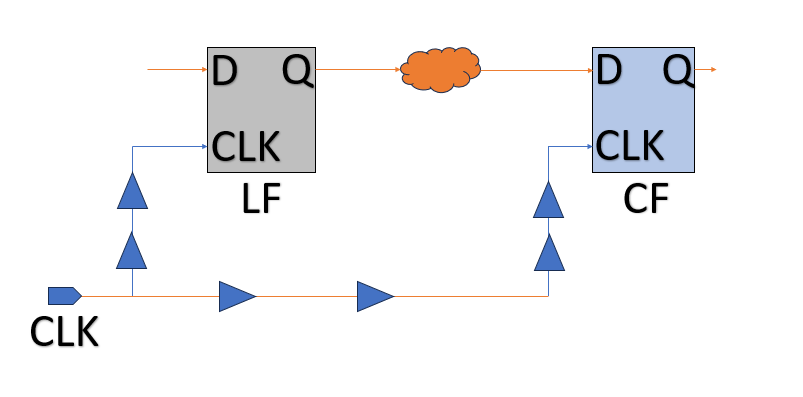Static Timing Analysis (STA) is crucial for verifying the timing behavior of digital circuits in ASIC and FPGA designs. One common issue during STA is the setup violation, which occurs when data does not meet the setup time requirement before a clock edge, leading to incorrect results.
What is a Setup Violation?
A setup violation happens when the data at a flip-flop’s input [ D pin] is not stable long enough before the clock edge. The setup time is the minimum period before the clock edge during which the data must remain stable. If this condition is violated, the flip-flop may capture incorrect data, leading to design failures due to metastability.
Setup time = Required time – Arrival Time = (Launch clock latency + CLK to Q delay + Comb. delay) – (Capture Clock latency + Clock Period – Library Setup requirement of Capture Flop) = (CLK to Q delay + Comb. delay) – (Clock Period – Library Setup requirement of Capture Flop + Clock Skew)
Clock Skew = Capture Clock latency – Launch Clock latency
Causes of Setup Violations
- Insufficient Clock Period – A short clock period doesn’t allow data to propagate through the logic in time.
- Long Path Delays or high Combination cell and net delays – Signals traveling through long or complex paths may not arrive in time.
- Improper Floorplanning – Poor placement of flip-flops and logic gates due to improper floorplan can introduce delay that in turn might cause setup violations.
- Clock Skew – Variations in the clock arrival times can cause some flip-flops to capture data too late. Negative skew is bad for setup.
- Clock Skew = Capture Clock latency – Launch Clock latency
- Process Variations [PVT & OCVs] – Manufacturing inconsistencies can impact signal propagation speed, like the SS [Slow Slow] process has more cell delays compared to the FF & TT processes.
How to Fix Setup Violations
Here are the key methods for addressing setup violations:
1. Optimize Combinational cell and net delays
Reducing the delay in the critical path ensures that data reaches the flip-flop on time. You can optimize the logic or use faster gates.
Solution:
- Simplify logic paths by using faster gates, upsizing cells in the data path, or VT Swapping or restructuring the logic.
- Consider using high-speed libraries for better performance.
2. Pipeline the Design
Pipelining involves adding flip-flops along the critical path to break long combinational paths into smaller stages, reducing delay.
Solution:
- Identify long critical paths and insert flip-flops to divide them into manageable stages.
- This technique helps achieve higher clock speeds.
3. Improve Floorplan
A poor floorplan can cause excessive wire lengths and delays. Proper placement of flip-flops and logic gates can mitigate timing issues.
Solution:
- Optimize the physical layout to minimize wire delays between flip-flops and logic gates.
- Use automated place-and-route tools for layout optimization.
4. Optimize Clock Skew
Clock skew happens when the clock signal reaches flip-flops at different times. This can be minimized by optimizing the clock tree.
Negative skew is bad for setup.
- Clock skew < 0
- Clock Skew = Capture Clock latency – Launch Clock latency 5.
Solution:
- Use clock tree synthesis (CTS) tools to balance the clock distribution.
- Ensure that the clock signal arrives simultaneously at all flip-flops as much as possible so we have less insertion delays and lesser negative skew.
5. Use Faster Technology
Switching to a faster technology process (e.g., from 65nm to 28nm) reduces delays and can help meet setup time requirements.
Solution:
- If possible, migrate to a faster technology node for better performance.
- Opt for advanced process technologies with lower delays.
6. Adjust Timing Constraints
Sometimes, overly stringent timing constraints can lead to violations. Loosening the constraints for less critical paths might help, though this should be done cautiously.
Solution:
- Review timing constraints and relax them where necessary.
- Focus on ensuring critical paths meet the required setup time.
7. Increase Clock Period [ Should be done by designers]
Increasing the clock period (reducing clock frequency) gives more time for signals to propagate through the logic and meet the setup time.
Solution:
- Slow down the clock to allow more time for data propagation.
- Ensure timing analysis tools reflect the new clock period.
Conclusion
Fixing setup violations in static timing analysis involves a mix of design optimizations and strategy adjustments. Whether you’re increasing the clock period, pipelining the design, optimizing critical paths, or improving clock distribution, each method contributes to achieving reliable timing performance. By addressing setup violations effectively, you ensure that your digital designs meet functional and performance requirements.
Implement these solutions to enhance your design’s reliability and speed while minimizing errors due to timing violations

![STATIC TIMING ANALYSIS [STA]: How to Fix Setup Violations](https://anuthipahal.com/wp-content/themes/neeon/assets/img/noimage.jpg)








Leave feedback about this